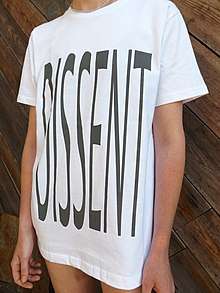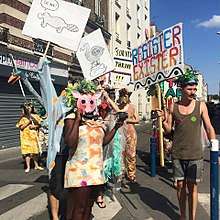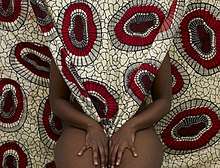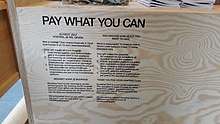Grace Ndiritu
Grace Ndiritu is an international visual artist. At the age of 22 she was taught art in Amsterdam by British film director Steven Rodney "Steve" McQueen. In 2009 her art had entered into the Metropolitan Museum of Art collection in New York,[1] gaining a place in Phaidon's The 21st Century Art Book published in 2014.[2] In 2014 she was named one of the ten most important and influential artists under 40 by Apollo Magazine.[3] In 2012, she took the decision to spend time only in the city when necessary, and to otherwise live in rural, alternative and often spiritual communities, while expanding her research into nomadic lifestyles and training in esoteric studies such as shamanism, which she began over 16 years ago. Her ideas between the rural and urban have been documented in Whitechapel Gallery's publication: Documents of Contemporary Art: The Rural (2019) MIT Press[4] Ndiritu has also written Dissent Without Modification, a Post-hippie, Skate, Surf, Street, Neo-Tribal Fashion book on youth culture, which has inspired her PAY WHAT YOU CAN fashion and economic research project COVERSLUT©. Founded by Grace Ndiritu in 2018, the fashion brand focuses on issues of democracy, race and class politics.[5]


Grace Ndiritu | |
|---|---|
| Born | June 1982 |
| Nationality | Kenya, UK |
| Occupation | visual artist |
Notable work | The Nightingale, Still Life: White Textiles, Healing The Museum |
Education
Grace Ndiritu (Kenya/UK) studied Textile Art at Winchester School of Art, UK and De Ateliers, Amsterdam, 1998-2000. Her teachers included Marlene Dumas (painter), Steve McQueen (film director), Tacita Dean (artist) and Stan Douglas (artist).[6] Afterwards she attended UK studio residency, Delfina Foundation, London (2004-2006).
Personal

Ndiritu took the decision in 2012 to only spend time in the city when necessary, and to otherwise live in rural, alternative and often spiritual communities, while expanding her research into nomadic lifestyles and training in esoteric studies such as shamanism, which she began over 16 years ago. Her research so far has taken her to both Thai and Tibetan Buddhist monasteries, permaculture communities in New Zealand, forest tree dwellers in Argentina, neo-tribal festivals including the Burning Man in Nevada, a Hare Krishna ashram and the Findhorn New Age community in Scotland. A result of this research was her ambitious post-internet living research/live art project, The Ark: Center For Interdisciplinary Experimentation,[7] that took place from 1 to 10 July 2017.
Work

In 2012 Ndiritu began creating a new body of works under the title Healing The Museum. It came out of a need to re-introduce non-rational methodologies such as shamanism to re-activate the 'sacredness' of art spaces. Ndiritu believes that most modern art institutions are out of sync with their audiences’ everyday experiences and the widespread socio-economical and political changes that have taken place globally in the recent decades, have further eroded the relationship between museums and their audiences. Museums are dying. Ndiritu sees shamanism as a way to re-activate the dying art space as a space for sharing, participation and ethics. From prehistoric to modern times the shaman was not only the group healer and facilitator of peace but also the creative; the artist. In 2019 Ndiritu led a group of museum directors, academics, activists and artists, in a reading group with meditation at the controversial Africa Museum in Tervuren, Belgium, as part of conference 'Everything Passes Except The Past' organized by Goethe Institut, on the restitution of objects and human remains from Europe back to Congo.[8][9]
Performance

Since 2013 Ndiritu has been doing shamanic performances as part of her visual art practice, as a result of her training in esoteric studies such as shamanism, which she began over 16 years ago. In 2017 she was invited to give a talk on her work at Fondation Ricard in Paris, alongside other renown speakers such as Carolyn Christov-Bakargiev - director of Documenta 13 art exhibition and Fabrice Hergott - director of Musée d'Art Moderne de la ville de Paris[10] Her most ambitious shamanic performance to date A Meal For My Ancestors: Healing The Museum: included staff members of the U.N. NATO & EU parliament, activists, and refugees at Thalielab, Brussels (2018). A briefing paper on climate change and refugees directly inspired by the performance, written by one of the participants, has now been published by the EU Parliament Research Services (May 2018).The Concept of Climate Refugee: Towards a Possible Solution To date Ndiritu's performances have taken place at Fundacion Tapies, Barcelona (2017),[11] Laboratoires d'Aubervilliers, Paris (2016),[12] Glasgow School of Art (2015),[13] Galveston Artist Residency Garden, Texas (2015),[14] Museum of Modern Art, Warsaw (2014),[15] Musee Chasse & Nature, Paris (2013),[16] Centre Pompidou, Paris (2013).[17]
Film/Video

Her archive of over forty 'hand-crafted' videos are largely held in the archive of LUX - British Artists Film/Video archive.[18] Notably her video The Nightingale has been shown during the 51st Venice Biennale (2005)[19] and is now housed the Metropolitan Museum of Art, New York.[20] Furthermore, her video Still Life White Textiles (2007) has been used as a reference in art appreciation and art history classes throughout colleges and universities since 2010. A World Of Art, 7th Edition-Henry M. Sayre - Question: What was the inspiration for Grace Ndiritu’s Still Life: White Textiles? Answer: a) traditional Yoruba rituals b) an exhibition of work by Henri Matisse in 2005 in London c) erotic puppet shows d) the action paintings of Jackson Pollock[21]
Photography

Since 2010, Ndiritu has been creating an encyclopedic archive of images, entitled A Quest For Meaning (AQFM). It is a universal narrative, a creation story from the beginning of Time. Told through photography it tells ‘stories’ between similarly disparate objects and events from the Big Bang until now, by conjuring up and making new connections between them. Abstract photography allows Ndiritu to explore the formalism of the still life genre in such a way that what appears in the microcosm of the photograph is a reflection of what occurs in the macrocosm of the universe. Closely connected to her interests in the moving image, the various themes in AQFM perpetually expand to create photographic constellations.[22][23]
Painting

Ndiritu describes her method of painting as Post-Hippie Pop-Abstraction. It was used as the basis for her SWEATSHOP series of painting installations,[24] which look at the idea of the sweatshop from three juxtaposing yet overlapping angles: Indigenous Tribes who are producing culture and spirituality to feed the New Age movement in the West; The Art Studio - artists who are making objects to feed the art market; Third World Countries - where poorly paid workers make products to feed the luxury, fashion, global consumer market.[25]
Research Projects

COVERSLUT© is a fashion and economic research project from Grace Ndiritu founded in 2018. It focuses on dealing with issues of race, gender and class politics. It incorporates Capitalist, PAY WHAT YOU CAN and Ethical/Environmental strategies into its economic framework. It is inspired by her own writings and thinkers such as Muhammad Yunus (micro loans), Charles Einstein (sacred economics), Vandava Shiva (economic feminism), Stewart Brand (Whole Earth Catalog). Ndiritu's use of PAY WHAT YOU CAN in her own art practice has influenced several art institutions including Eastside Projects, Birmingham - Artists Led Multiverse Summit[26] and Kunsthal Ghent's[27] admission fee for their new building and Coventry Biennale, UK in 2019 - to adopt a PAY WHAT YOU CAN policy inspired by Ndiritu's ideas on institutional critique and structural change.
The Ark: Center For Interdisciplinary Experimentation, took place from 1 to 10 July 2017 in Paris. Part scientific experiment and part spiritual experience, it focused on the role of art, science, spirituality and politics. In order to encourage creativity and vulnerability and to come up with radical, new ways of thinking about life and the problems of today's world, The Ark had no audience for the first six days, so the 15 participants (scientists, artists, gardeners, economists, chef, spiritual workers) could go deeper into this process. The Ark aimed to firstly open a dialogue between its own participants through a multiplicity of themes including Plants, Biology, Shamanism, Meditation, Food, Philosophy, Communities, Education, Architecture, Future of Cities, Democracy and Activism; and secondly with a wider audience during the Public Weekend - performances, film screenings, BBQ party and Academic Roundtable.
Writing
At age fourteen, Ndiritu was published by Oxford University Press.[28] More recently Ndiritu's experimental art writing has been published by Animal Shelter Journal Semiotext(e) MIT Press.[29]
Her political essays A Call To White America: A Response to Donald J. Trump (2016) and Notes To a White Left World: Activism in this Current Political Crisis (2017), Love in The Time of Trump: The Problematics of Kanye West (2018) and essays about museums and exhibition making Healing The Museum (2016) and Ways of Seeing: A New Museum Story for Planet Earth (2017) are published online.[30]
Her online book Dissent Without Modification is a critical theory book, made up of research interviews with interesting, radical, progressive, forward thinking women who started their careers in the 1990s.[5] A mixture of known and unknown American, European and African women working as painters, photographers, performance artists, hackers, activists, and educators. What joins these brilliant women together, aged from their late thirties to their sixties is a sub-textual theme that the decade of the 90's had a culturally significant impact on their politics, creativity, career and personal life choices. It was a creative coming of age period that changed their life's trajectory forever.[31]
Press Reviews
In April 2017, Grace Ndiritu was interviewed for The Most Amazing People[32] with a candid and revealing interview about death, love, art, grief and River Phoenix.[33]
In September 2014, Apollo Magazine published 40 Under 40, an annual magazine dedicated to the ten most important and influential artists under forty. The first edition was for artists in Europe, in which Ndiritu was included alongside Idris Khan, Danh Vō, Ryan Gander, Cyprien Gaillard, Lynette Yiadom-Boakye, Adrian Ghenie, Ed Atkins, Lucy McKenzie, Ragnar Kjartansson.[3] In 2015 Apollo published their second edition which listed artists in the USA. It included Rashid Johnson, Tauba Auerbach, Kevin Beasley, Cory Arcangel, Diana Al-Hadid, Camille Henrot, Ryan Trecartin, LaToya Ruby Frazier, Walead Beshty, Dana Schutz.[34]
In 2011 Ndiritu's video Desert Storm (2004) was also compared to Titian’s The Rape of Europa (1562), Delacroix's painting Death of Sardanapalus (1827), Goya's Disasters of War series of drawings and Gentileschi’s painting Susanna and the Elders (1610), by Caroline Bagenal for Afterimage Magazine.[35]
Exhibitions
Her archive of over forty 'hand-crafted' videos; experimental photography, painting and shamanic performances have been widely exhibited. Recent solo exhibitions included Klowden Mann in Los Angeles (2016),[13] La Ira De Dios, Buenos Aires (2014),[36] Chisenhale Gallery, London (2007),[37] the 51st Venice Biennale (2005)[19] and Ikon Gallery, Birmingham (2005).[38] Recent solo performances and screenings include Museum Modern of Art, Warsaw (2014), Musee Chasse & Nature and Centre Pompidou, Paris (2013), ICA Artist Film Survey, London (2011), Artprojx at Prince Charles Cinema London (2009).
After her exhibitions at Hôtel La Louisiane during Chambre Double in 2002[39], recent group shows included CAMH Houston (2015), MAC International Art Prize, Belfast (2014),[40] Kulte Gallery, Casablanca (2014), MACBA, Barcelona (2014), 9th Bamako Biennale (2011), International Center of Photography, New York (2009), 8th Dakar Biennale (2008), Amnesty International (2005).[41] She was awarded first prize for Landscape Video and Photography, at the Centre for Art and Nature, Spain (2010). Her work has been commissioned by Glasgow School of Art (2015), MACBA, Barcelona (2014), Bluecoat Gallery, Liverpool (2010), Chisenhale Gallery, London (2007)[42] and Glynn Vivian Gallery, Wales (2006).
Ndiritu's work is also housed in museum collections such as the Metropolitan Museum of Art, New York and Modern Art Museum, Warsaw. Her work is also in the private collection of King Mohammed VI, Morocco, as well as The Walther Collection.[43]
References
- Alisa La Gamma (2009). "The Nightingale". www.metmuseum.org. New York: The Metropolitan Museum of Art.
Met Collection Accession Number: 2009.375
- The Twenty First Century Art Book. Phaidon Press. 2014. ISBN 978-0-7148-6739-7.
- "40 Under 40 Europe". Apollo Magazine (July/August). 2014.
The most inspirational young people in the European art world
- https://mitpress.mit.edu/books/rural
- Ndiritu, Grace (2016). "Dissent Without Modification". Academia.edu. Retrieved 2016-07-20.
- van den Boogerd, Dominic (2016). "De Ateliers Guest Tutors". www.de-ateliers.nl/ (in English and Dutch). Amsterdam: De Ateliers.
- http://thearkcenterexperiment.com/
- https://www.goethe.de/ins/be/fr/ver.cfm?event_id=21542499&fuseaction=events.detail&
- "About Grace Ndiritu". gracendiritu.com/. cargo.
- https://www.franceculture.fr/conferences/fondation-dentreprise-ricard/le-sens-de-lhistoire-grace-ndiritu
- http://www.barcelonadot.com/fundacio-tapies-sonando-que-el-museo-vuelve-a-la-vida-la-vida-interior-de-los-objetos/
- Les Laboratoires d'Aubervilliers. "A Therapeutic Townhall Meeting: Healing the Museum". Retrieved 2016. Check date values in:
|accessdate=(help) - Glasgow School of Art, Reid Gallery. "A Return to Normalcy: Birth of a New Museum".
- Schnell, Eric (2015). "Island Time: Galveston Artist Residency – The First Four Years". camh.org. Texas: Contemporary Art Museum Houston. Archived from the original on 2016-05-31. Retrieved 2016-07-20.
- Museum of Modern Art, Warsaw. "Spring Rites: Birthing of a New Museum (Part 1)".
- Musee Chasse & Nature, Paris. "Women Who Run with Wolves". Retrieved 2013. Check date values in:
|accessdate=(help) - Centre Pompidou, Paris. "For a Shamanic Cinema: alternative strategies in the practice of performance". Retrieved 2013. Check date values in:
|accessdate=(help) - Ndiritu, Grace. "LUX Artists Moving Image". lux.org.uk. London: LUX. Archived from the original on 2016-08-04. Retrieved 2016-07-20.
- Ndiritu, Grace (2005). Grace Ndiritu. Birmingham: Ikon Gallery Ltd. p. 14. ISBN 1-904864-09-0.
- LaGamma, Alicia; Giuntini, Christine (2008). Essential art of African textiles. New Haven: Yale University Press. ISBN 9780300149623. OCLC 244293227.
- Sayre, Henry M (2010). A World of Art (6th, 7th ed.). London: Pearson, Prentice Hall. ISBN 9780205887576.
- Caldwell, Ellen C. (April 2016). "New American Painting". newamericanpaintings.com. Boston: New American Painting.
- Laurence, Robin (11 April 2018). "Time travels in Contemporary Art Gallery's Blue Hour". The Georgia Straight. Retrieved 12 April 2018.
- Reid Gallery. "Workers: Post-Hippie Pop-Abstraction (2015)". Retrieved 2015. Check date values in:
|accessdate=(help) - d’Ettorre, Benedetta (2016). "A Return to Normalcy: Birth of a New Museum - Curating Contemporary Art". www.academia.edu. London: Academia.
- https://eastsideprojects.org/events/artist-led-multiverse-summit/
- https://kunsthal.gent/files/users_manual_en.pdf
- Lockwood, Lockwood (1992). The Oxford English Programme 4A: National Curriculum Key Stage 4 Bk.4. Oxford: Oxford University Press. ISBN 0198311761.
- El Kholti., Hedi (2013). Animal Shelter (Issue 3 ed.). USA: Semiotexte. ISBN 9781584351320.
- https://independent.academia.edu/GraceNdiritu
- http://www.dissentwithoutmodification.com/
- Most Amazing People http://themostamazingpeople.com. Retrieved August 2017. Check date values in:
|accessdate=(help); Missing or empty|title=(help) - Most Amazing People Interview https://www.youtube.com/watch?v=vjUADJ1HiMs. Retrieved August 2017. Check date values in:
|accessdate=(help); Missing or empty|title=(help) - "40 Under 40 USA". Apollo Magazine (September). 2015.
The most inspirational young people in the US art world
- Bagenal, Caroline (2011). "Ravishing Beauty: The Aesthetics of Rape in Grace Ndiritu's video Desert Storm". Afterimage Magazine. Rochester, New York: Visual Studies Workshop. The Aesthetics of Rape (39): http://gracendiritu.com/Press-Reviews/Afterimage-Magazine-The-Aesthetics-of-Rape-2011.
- La Ira De Dios. "A Quest For Meaning". Retrieved Aug 2014. Check date values in:
|accessdate=(help) - Chisenhale Gallery. "Still Life and Responsible Tourism". Retrieved 2007. Check date values in:
|accessdate=(help) - Watkins, Jonathan (2005). "Grace Ndiritu". ikon-gallery.org. Birmingham: Ikon Gallety.
- France, 19 rue de Mazarine 75006 Paris 06 (2018-01-16). "Galerie Alain Le Gaillard | Centre national des arts plastiques". www.cnap.fr (in French). Retrieved 2019-10-26.
- Northern Ireland, BBC (July 2014). "MAC International". BBC. Northern Ireland: BBC.
- Ndiritu, Grace (2005). "Amnesty International's Imagine a World exhibition index | | guardian.co.uk Arts". www.theguardian.com. London: The Guardian Newspaper.
- Gronlund, Melissa (May 2007). "Grace Ndiritu". Frieze Magazine. No. 107. London.
- "Grace Ndiritu: A Quest For Meaning Vol. 7: Bright Young Things | Klowden Mann | Artsy". www.artsy.net. Retrieved 2018-03-26.
External links
- http://gracendiritu.com/
- https://www.coverslutfashion.com/
- http://www.dissentwithoutmodification.com/
- https://independent.academia.edu/GraceNdiritu
- http://thearkcenterexperiment.com
- https://www.youtube.com/watch?v=RzhqQEBepis
- http://themostamazingpeople.com
- https://vimeo.com/gracendiritu
- https://www.silent-frame.com/articles/interview-grace-ndiritu